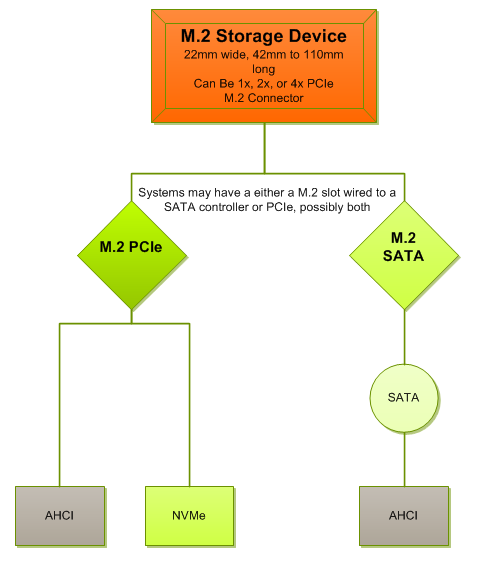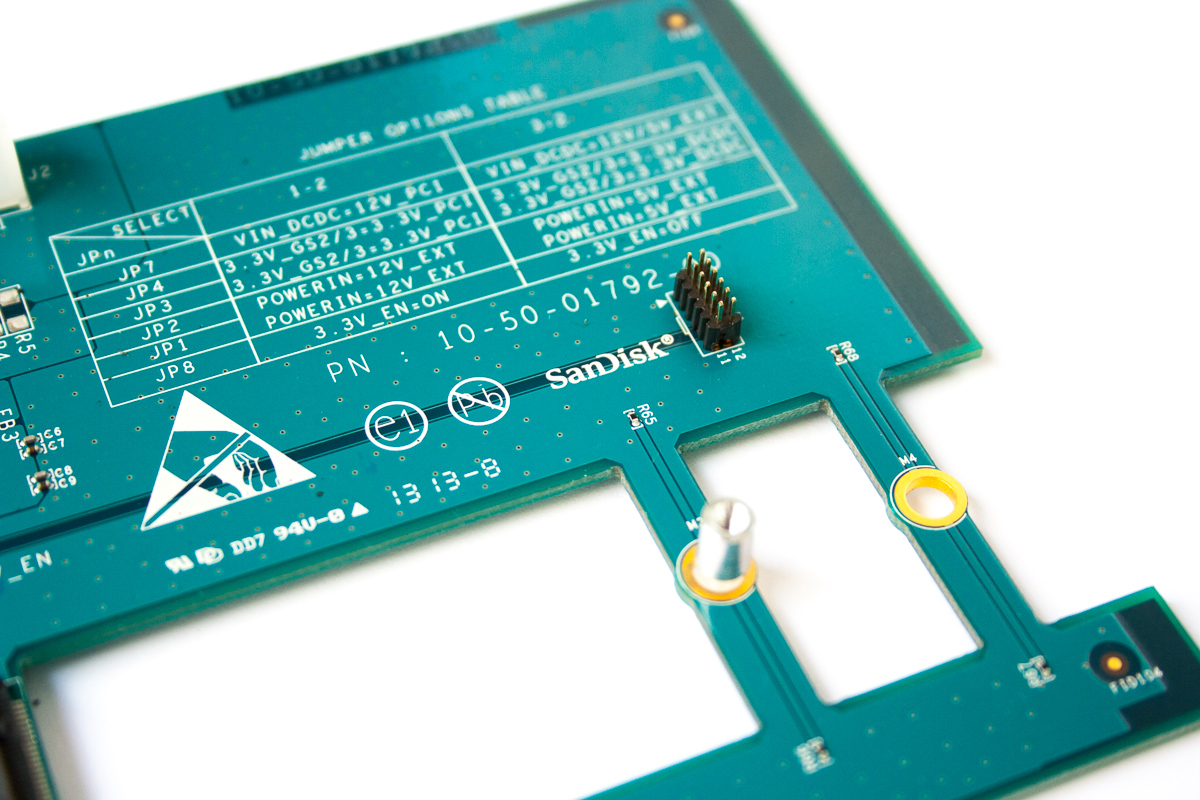SanDisk A110 PCIe SSD: Armed With The New M.2 Edge Connector
We got our hands on an early sample of SanDisk's A110 SSD. So what? Big deal? Not a chance. This thing is PCI Express-attached and sports the new M.2 edge connector. Read on to learn more about the next generation of solid-state storage connectivity.
More On M.2 And SanDisk's Fancy PCIe Adapter Card
In case the previous page didn't clarify M.2 for you, don't sweat it. I created the diagram above to (hopefully) inject some clarity, since this entire discussion gets a little confusing. In reality, M.2 refers to the connector manufactured by companies like Kyocera and Tyco. Again, solid-state drives employing the M.2 connector are 22 mm wide, better accommodating NAND packages and processors down the length of the PCB. That length can be 42, 60, 80, and 110 mm. So, a M.2 2260 is 22 mm wide and 60 mm long. Get it?
That's the obvious, physical stuff. There's also plenty to digest when it comes to the technology on an M.2-based SSD. Use a SATA controller, and you end up with something similar to an mSATA-equipped drive (so long as the M.2 slot is wired up to a corresponding SATA port on your motherboard; otherwise, there needs to be a PCIe-to-SATA bridge chip in play).
Then you have native PCI Express controllers like the one on SanDisk's A110. It boasts Marvell's 9183, which, communicates across those two lanes of second-gen PCI Express. There will be native NVMe-based controllers that attach via PCIe and work with the upcoming host interface. For now, though, the A110 is limited to AHCI. This is the case for every current and most upcoming M.2 PCIe-based drives.
Still following along? Let's pile on some more. SSDs with M.2 connectors can use one, two, or as many as four PCI Express lanes. SanDisk's sample employs two PCIe 2.0 lanes, which should become fairly standard, we understand.
We probably don't need to tell you that the test platforms already in our lab don't yet support M.2. One motherboard vendor is starting to show off LGA 1150-based platforms with M.2 linked to one PCIe lane, but we'd prefer to use our main SSD testing setup. Not only would stepping over to a new board yield different results, but limiting the A110 to one lane would inhibit its performance.
That's why we need this bad boy:
This is SanDisk's PCIe x4 to M.2 adapter. Without a proper slot to accommodate the A110, we need this full-height card to test any SSD with an M.2 connector. These are for testing and development, and come with a variety of arcane jumpers, along with a USB port for debugging. The PCIe-based M.2 can be powered through either the PCIe bus or the four pin Molex. That'll come in handy for power consumption testing.
Get Tom's Hardware's best news and in-depth reviews, straight to your inbox.
With just two different PCIe M.2 form factors, the adapter doesn't need to support every length. Installing the M.2-based SSD is easy; plug it in the connector and then secure it with a cylindrical barrel.
| Test Hardware | |
|---|---|
| Processor | Intel Core i5-2400 (Sandy Bridge), 32 nm, 3.1 GHz, LGA 1155, 6 MB Shared L3, Turbo Boost Enabled |
| Motherboard | Gigabyte G1.Sniper M3 |
| Memory | G.Skill Ripjaws 8 GB (2 x 4 GB) DDR3-1866 @ DDR3-1333, 1.5 V |
| System Drive | Kingston HyperX 3K 240 GB, Firmware 5.02 |
| Drive(s) Under Test | SanDisk A110 256 GB M.2 PCIe x2, Firmware: A200100 |
| Comparison Drives | Silicon Motion SM226EN 128 GB SATA 6Gb/s, Firmware: M0709A |
| Row 6 - Cell 0 | Crucial M500 120 GB SATA 6Gb/s, Firmware: MU02 |
| Row 7 - Cell 0 | Crucial M500 240 GB SATA 6Gb/s, Firmware: MU02 |
| Row 8 - Cell 0 | Crucial M500 480 GB SATA 6Gb/s, Firmware: MU02 |
| Row 9 - Cell 0 | Crucial M500 960 GB SATA 6Gb/s, Firmware: MU02 |
| Row 10 - Cell 0 | Samsung 840 EVO 120 GB SATA 6Gb/s, Firmware: EXT0AB0Q |
| Row 11 - Cell 0 | Samsung 840 EVO 240 GB SATA 6Gb/s, Firmware: EXT0AB0Q |
| Row 12 - Cell 0 | Samsung 840 EVO 480 GB SATA 6Gb/s, Firmware: EXT0AB0Q |
| Row 13 - Cell 0 | Samsung 840 EVO 1 TB SATA 6Gb/s, Firmware: EXT0AB0Q |
| Row 14 - Cell 0 | SanDisk Ultra Plus 64 GB SATA 6Gb/s, Firmware: X211200 |
| Row 15 - Cell 0 | SanDisk Ultra Plus 128 GB SATA 6Gb/s, Firmware X211200 |
| Row 16 - Cell 0 | SanDisk Ultra Plus 256 GB SATA 6Gb/s, Firmware X211200 |
| Row 17 - Cell 0 | Samsung 840 Pro 256 GB SATA 6Gb/s, Firmware DXM04B0Q |
| Row 18 - Cell 0 | Samsung 840 Pro 128 GB SATA 6Gb/s, Firmware DXM04B0Q |
| Row 19 - Cell 0 | SanDisk Extreme II 120 GB, Firmware: R1311 |
| Row 20 - Cell 0 | SanDisk Extreme II 240 GB, Firmware: R1311 |
| Row 21 - Cell 0 | SanDisk Extreme II 480 GB, Firmware: R1311 |
| Row 22 - Cell 0 | Seagate 600 SSD 240 GB SATA 6Gb/s, Firmware: B660 |
| Row 23 - Cell 0 | Intel SSD 525 30 GB mSATA 6Gb/s, Firmware LLKi |
| Row 24 - Cell 0 | Intel SSD 525 60 GB mSATA 6Gb/s, Firmware LLKi |
| Row 25 - Cell 0 | Intel SSD 525 120 GB mSATA 6Gb/s, Firmware LLKi |
| Row 26 - Cell 0 | Intel SSD 525 180 GB mSATA 6Gb/s, Firmware LLKi |
| Row 27 - Cell 0 | Intel SSD 525 240 GB mSATA 6Gb/s, Firmware LLKi |
| Row 28 - Cell 0 | Intel SSD 335 240 GB SATA 6Gb/s, Firmware: 335s |
| Row 29 - Cell 0 | Intel SSD 510 250 GB SATA 6Gb/s, Firmware: PWG2 |
| Row 30 - Cell 0 | OCZ Vertex 3.20 240 GB SATA 6Gb/s, Firmware: 2.25 |
| Row 31 - Cell 0 | OCZ Vector 256 GB SATA 6Gb/s, Firmware: 2.0 |
| Row 32 - Cell 0 | Samsung 830 512 GB SATA 6Gb/s, Firmware: CXMO3B1Q |
| Row 33 - Cell 0 | Crucial m4 256 GB SATA 6Gb/s Firmware: 000F |
| Row 34 - Cell 0 | Plextor M5 Pro 256 GB SATA 6Gb/s Firmware: 1.02 |
| Row 35 - Cell 0 | Corsair Neutron GTX 240 GB SATA 6Gb/s, Firmware: M206 |
| Graphics | MSI Cyclone GTX 460 1 GB |
| Power Supply | Seasonic X-650, 650 W 80 PLUS Gold |
| Chassis | Lian Li Pitstop |
| RAID | LSI 9266-8i PCIe x8, FastPath and CacheCade AFK |
| System Software and Drivers | |
| OperatingSystem | Windows 7 x64 Ultimate |
| DirectX | DirectX 11 |
| Drivers | Graphics: Nvidia 314.07RST: 10.6.1002IMEI: 7.1.21.1124Generic AHCI: MSAHCI.SYS |
| Benchmarks | |
|---|---|
| Tom's Hardware Storage Bench v1.0 | Trace-Based |
| Iometer 1.1.0 | # Workers = 1, 4 KB Random: LBA=16 GB, varying QDs, 128 KB Sequential, 8 GB LBA Precondition, Exponential QD Scaling |
| PCMark 7 | Secondary Storage Suite |
| PCM Vantage | Storage Suite |
Current page: More On M.2 And SanDisk's Fancy PCIe Adapter Card
Prev Page SanDisk A110 256 GB: Introducing The M.2 SSD Form Factor Next Page Results: Sequential Performance-
Mike Friesen Awesome new stuff. Can't wait to see if this drive actually uses the full potential of the M2, and if Samsung or OCZ can one-up them.Reply -
cryan Reply11487924 said:Awesome new stuff. Can't wait to see if this drive actually uses the full potential of the M2, and if Samsung or OCZ can one-up them.
Samsung actually has some pretty awesome M.2 PCIe action going on. We're trying to get our hands on everything, so stay tuned.
Regards,
Christopher Ryan
-
It will be nice to see vendors implement the NVMe connectors in the desktop mobo's, which in turn will redefine case design, as less storage space will be required for storage. I am aware that the initial intent is to direct these at the mobile market, but desktops can benefit as well.Reply
-
cryan Reply11488018 said:It will be nice to see vendors implement the NVMe connectors in the desktop mobo's, which in turn will redefine case design, as less storage space will be required for storage. I am aware that the initial intent is to direct these at the mobile market, but desktops can benefit as well.
You'll really see NVMe take off on the desktop with the move towards SATA Express. A SSD on SATA Express will leverage NVMe and two PCIe Gen 3 lanes. Though some motherboards will (and already do) have M.2 connectors, M.2 really makes more sense in mobile applications. M.2 will only get traction on the desktop insofar as it will begin to replace mSATA. Tons of mainboards, especially smaller form factor products embrace mSATA, and moving to M.2 is a natural transition. However, M.2 drives are hard to find right now, and we really won't see a plethora of options until next year.
Regards,
Christopher Ryan
-
nekromobo I got M.2 toshiba ssd in my Sony Vaio Pro 13.. review that?Reply
and it should have samsung M.2 in some countries.. -
CaedenV I may no longer have motivation to upgrade my system based on CPU specs, but with DDR4, M.2, new restive storage based SSDs, and better chipset features I will still have enough reason to upgrade in a year or two.Reply -
jimmysmitty Reply11488122 said:11488018 said:It will be nice to see vendors implement the NVMe connectors in the desktop mobo's, which in turn will redefine case design, as less storage space will be required for storage. I am aware that the initial intent is to direct these at the mobile market, but desktops can benefit as well.
You'll really see NVMe take off on the desktop with the move towards SATA Express. A SSD on SATA Express will leverage NVMe and two PCIe Gen 3 lanes. Though some motherboards will (and already do) have M.2 connectors, M.2 really makes more sense in mobile applications. M.2 will only get traction on the desktop insofar as it will begin to replace mSATA. Tons of mainboards, especially smaller form factor products embrace mSATA, and moving to M.2 is a natural transition. However, M.2 drives are hard to find right now, and we really won't see a plethora of options until next year.
Regards,
Christopher Ryan
That's what I was thinking. SATA Express is going to be fast enough for now as I have used PCIe SSDs before (OCZ Revo based drive) and compared to my 520 its hard to notice a difference, especially since there are other bottlenecks stopping it from being able to utilize that bandwidth.
This will be great for ultra portable systems though and ITX systems.
-
cryan Reply11488367 said:I got M.2 toshiba ssd in my Sony Vaio Pro 13.. review that?
and it should have samsung M.2 in some countries..
Absolutely... just send it my way and consider it done.
Regards,
Christopher Ryan
-
mikeangs2004 will there be RAID or SLI/CFX for PCIe based SSD's?Reply
I don't think so b/c it's already way above 6G limit.



